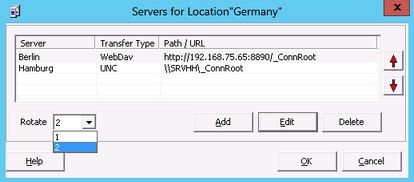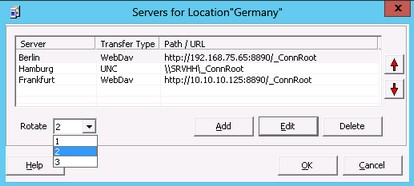|
After all the servers for the location are entered you have to determine, when the ixi-UMS MDS transfers messages to these ixi-UMS Kernels.

|
This is determined via the selection "Rotate".
Example 1: Two servers are assigned to this location
The following example refers to the entries you can see left:
|
Rotate: 1
|
All the messages for this location are transferred to the server "Berlin", because it is on top of the list. If this Kernel is not available, the messages are sent to the server "Hamburg", which is in second place (high availability).
|
Rotate: 2
|
The messages for this location are sent to the first (Berlin) and to the second (Hamburg) server in the list alternatively.
There are always so many messages transferred to the server as stated at "File Transfer", then the other server is addressed (load balancing).
|

|
Example 2: Three servers are assigned to the location
The following example refers to the entries you can see left:
|
Rotate: 1
|
All the messages for this location are transferred to the server "Berlin", because it is on top of the list. If this Kernel is not available, all the messages are sent to the Kernel "Hamburg", which is in second place. If neither of these Kernels is available, the third in the list (Kernel "Wien") is addressed.
|
Rotate: 2
|
The messages for this location are sent to the first (Berlin) and to the second (Hamburg) server in the list alternatively.
There are always so many messages transferred to the server as stated at "File Transfer", then the other server is addressed.
If none of both the servers is available, the server Wien is used.
|
Rotate: 3
|
All the messages for this location are sent to the three servers entered in the list alternatively.
|
The order of the servers can be changed via the arrows.

|
Even if a server is never set up for the sending directly (standby), its directories are checked for incoming messages.
|
|

